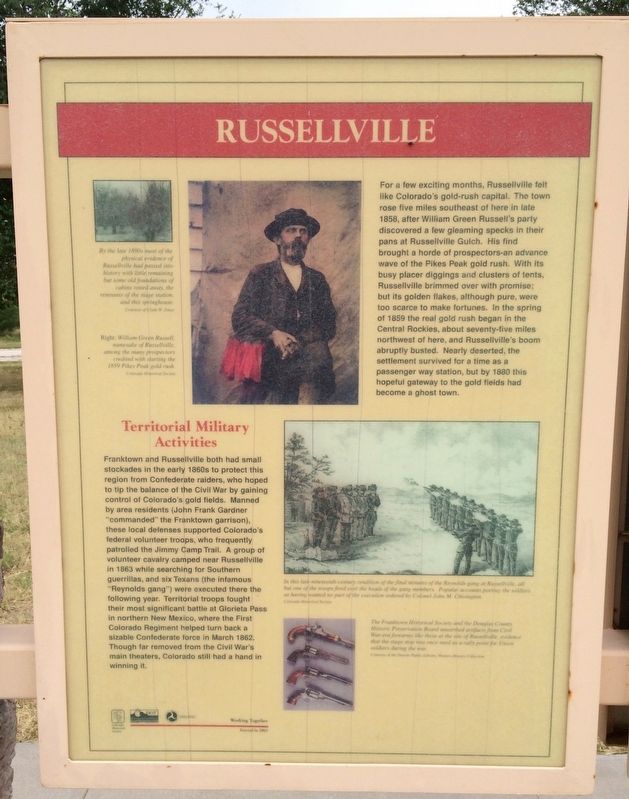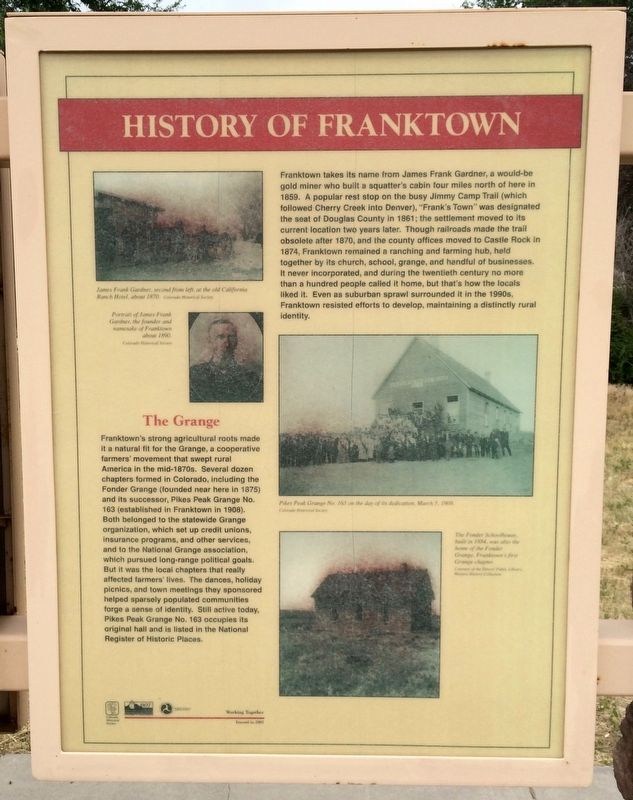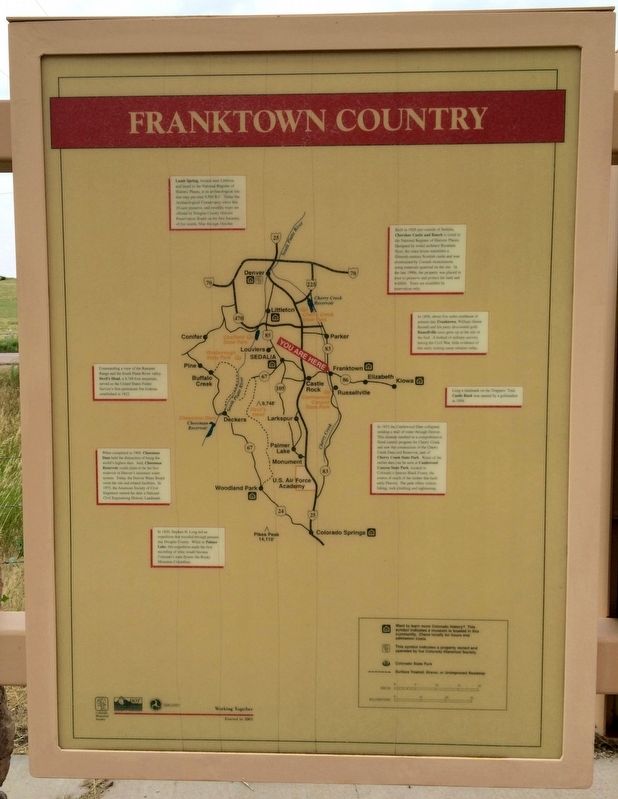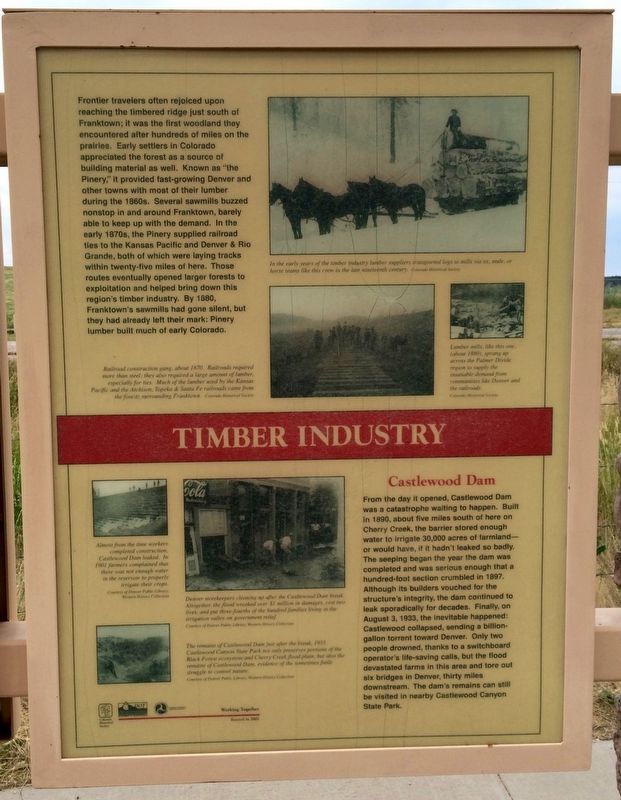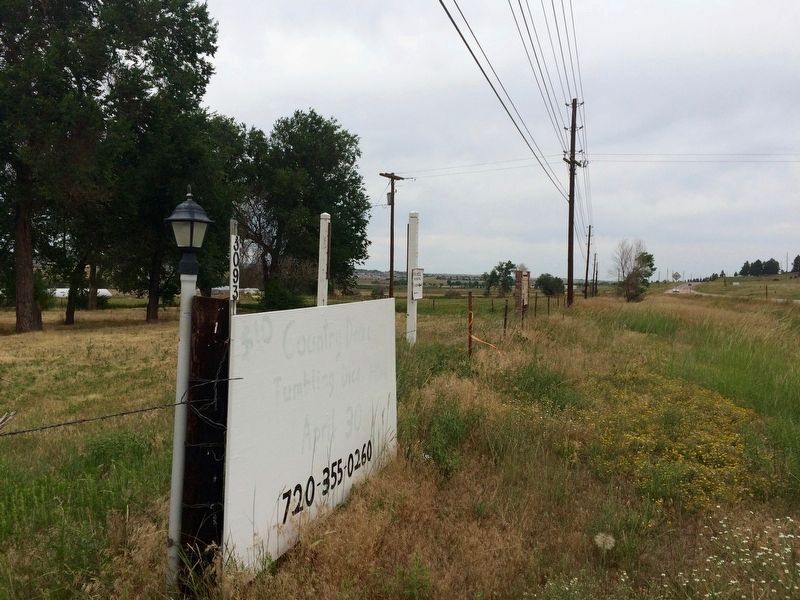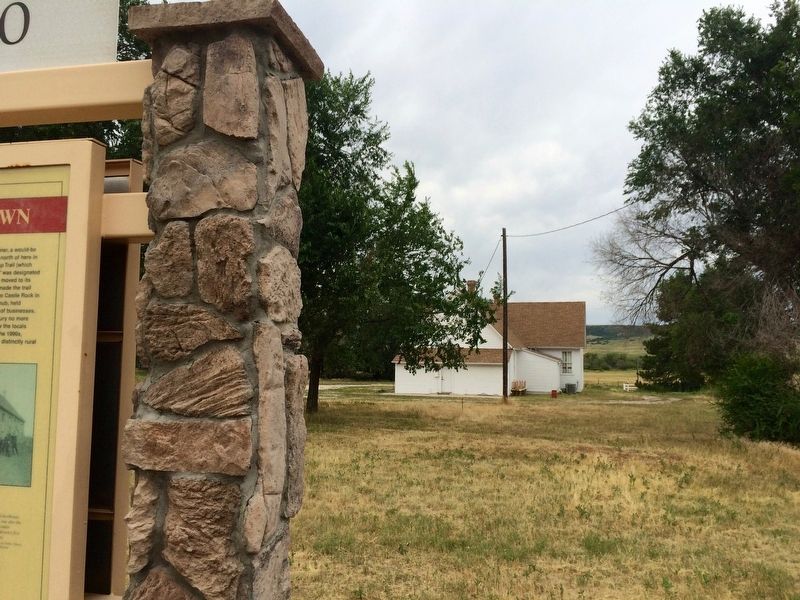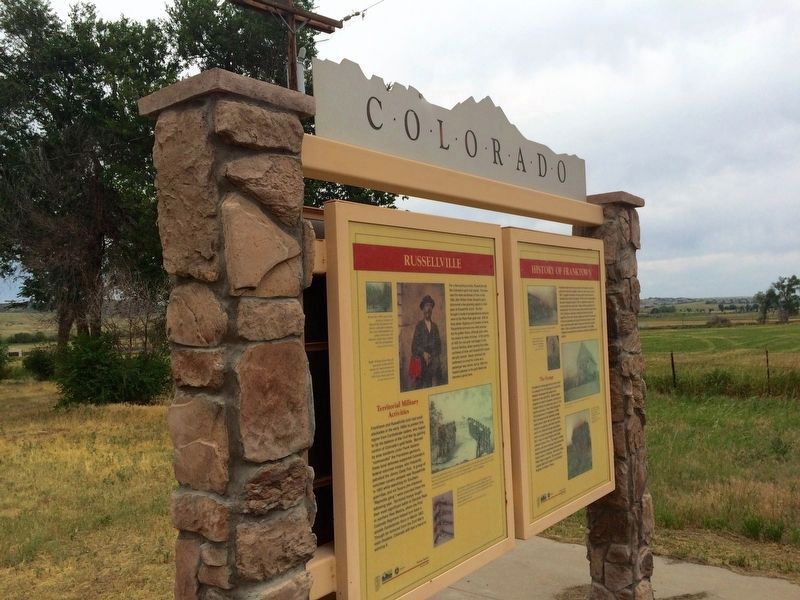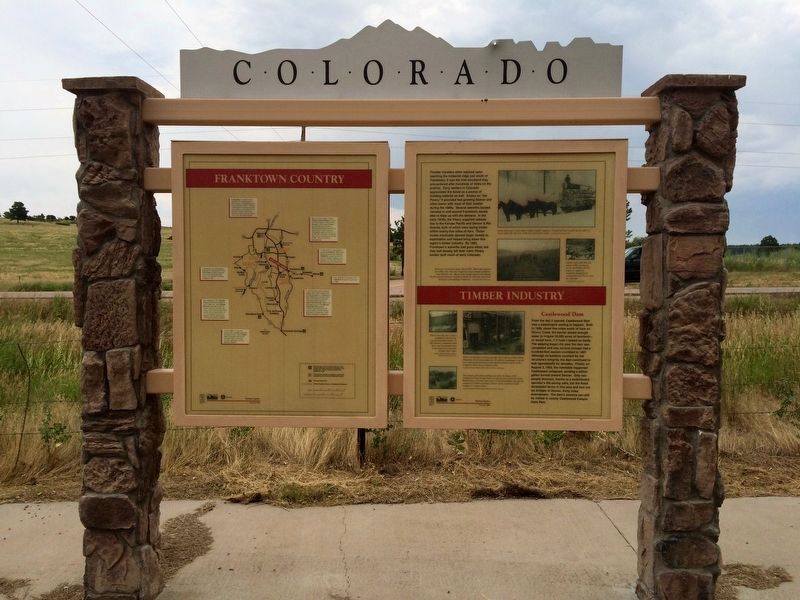Near Franktown in Douglas County, Colorado — The American Mountains (Southwest)
Russellville - History of Franktown / Franktown Country - Timber Industry
Panel 1
For a few exciting months, Russellville felt like Colorado's gold-rush capital. The town rose five miles southeast of here in late 1858, after William Green Russell discovered a few gleaming specks in his pan at Russellville Gulch. His find brought a horde of prospectors-an advance wave of the Pikes Peak gold rush. With its busy placer diggings and clusters of tents, Russellville brimmed over with promise; but its nuggets, although pure, were too scarce to make fortunes. In the spring of 1859 the real gold rush began in the Central Rockies, about seventy-five miles northwest of here, and Russellville's boom abruptly busted. Nearly deserted, the settlement survived for a time as a passenger way station, but by 1880 this hopeful gateway to the gold fields had become a ghost town.
Territorial Military Activities
Franktown and Russellville both had small stockades in the early 1860s to protect this region from Confederate raiders, who hoped to tip the balance of the Civil War by gaining control of Colorado's gold fields. Manned by area residents (John Frank Gardner "commanded" the Franktown garrison), these local defenses supported Colorado's federal volunteer troops, who frequently patrolled the Jimmy Camp Trail. A group of volunteer cavalry camped near Russellville in 1863 while searching for Southern guerrillas, and six Texans (the infamous "Reynolds gang") were executed there the following year. Territorial troops fought their most significant battle at Glorieta Pass in northern New Mexico, where the First Colorado Regiment helped turn back a sizable Confederate force in March 1862. Though far removed from the Civil War's main theaters, Colorado still had a hand in winning it.
Images on this panel:
Drawing: Execution of the Russell Gang
(Caption) In this late-nineteenth-century rendition of the final minutes of the Reynolds gang at Russellville, southeast of Franktown, all but one of the troops fired over the heads of the gang members. Popular accounts portray the soldiers as having wanted no part of the execution ordered by Colonel John M. Chivington.
Photo Courtesy of the Colorado Historical Society
Photo: Civil War-era Firearms
Caption) The Franktown Historical Society and the Douglas County Historic Preservation Board unearthed artifacts from Civil War-era forearms like these at the site of Russellville, evidence that the stage stop was once used as a rally point for Union soldiers during the war.
Photo Courtesy of the Denver Public Library
Photo: Portrait of William Greene Russell
(Caption) William Green Russell, namesake of Russellville, among the many prospectors credited with starting the 1859 Pikes Peak gold rush.
Photo Courtesy of the Colorado Historical Society
Photo: Springhouse in Russellville
(Caption) By the late 1890s most of the physical evidence of William Green Russell's original camp had passed into history with little remaining but some old foundations of cabins rotted away, the remnants of the stage station, and this springhouse.
Photo Courtesy of Clyde W. Jones
Panel 2
Franktown takes its name from James Frank Gardner, a would-be gold miner who built a squatter's cabin four miles north of here in 1859. A popular rest stop on the busy Jimmy Camp Trail (which followed Cherry Creek into Denver), "Frank's Town" was designated the seat of Douglas County in 1861; the settlement moved to its current location two years later. Though railroads made the trail obsolete after 1870, and the county offices moved to Castle Rock in 1874, Franktown remained a ranching and farming hub, held together by its church, school, grange, and handful of businesses. It never incorporated, and during the twentieth century no more than a hundred people called it home, but that's how the locals liked it. Even as suburban sprawl surrounded it in the 1990s, Franktown resisted efforts to develop, maintaining a distinctly rural identity.
The Grange
Franktown's strong agricultural roots made it a natural fit for the grange, a cooperative farmers' movement that swept rural America in the mid-1870s. Several dozen chapters formed in Colorado, including the Fonder Grange (founded near here in 1875) and its successor, Pikes Peak Grange No. 163 (established in Franktown in 1908). Both belonged to the statewide grange organization, which set up credit unions, insurance programs, and other services, and to the national grange association, which pursued long-range political goals. But it was the local chapters that really affected farmers' lives. The dances, holiday picnics, and town meetings they sponsored helped sparsely populated communities forge a sense of identity. Still active today, Pikes Peak Grange No. 163 occupies its original hall, which stands just north of here and is listed in the National Register of Historic Places.
Images on this panel:
Photo: Pikes Peak Grange
Pikes Peak Grange No. 163 on the day of its dedication, March 5, 1909.
Photo Courtesy of the Colorado Historical Society
Photo: Schoolhouse
The Fonder Schoolhouse, built in 1881, was also the home of the Fonder Grange, Franktown's first Grange chapter.
Photo Courtesy of the Denver Public Library
Photo: James Frank Gardner
Portrait of James Frank Gardner, the founder and namesake of Franktown, about 1890.
Photo Courtesy of Colorado Historical Society
Photo: Men and wagon
James Frank Gardner, second from left, at the old California Ranch Hotel, about 1870.
Photo Courtesy of Colorado Historical Society
Panel 3
Frontier travelers often rejoiced upon reaching the timbered ridge just south of Franktown; it was the first woodland they encountered after hundreds of miles on the prairies. Early settlers in Colorado appreciated the forest, too-as a source of building material. Known as "the Pinery," it provided fast-growing Denver and other towns with most of their lumber during the 1860s. Several sawmills buzzed nonstop in and around Franktown, barely able to keep up with the demand. In the early 1870s, the Pinery supplied railroad ties to the Kansas Pacific and Denver & Rio Grande, both of which were laying tracks within twenty-five miles of here. Those routes eventually opened larger forests to exploitation and helped bring down this region's timber industry. By 1880, Franktown's sawmills had gone silent, but they had already left their mark: Pinery lumber built much of early Colorado.
Castlewood
Dam
From the day it opened, Castlewood Dam was a catastrophe waiting to happen. Built in 1890, about five miles south of here on Cherry Creek, the barrier stored enough water to irrigate 30,000 acres of farmland-or would have, if it hadn't leaked so badly. The seeping began the year the dam was completed and was serious enough that a hundred-foot section crumbled in 1897. Although its builders vouched for the structure's integrity, the dam continued to leak sporadically for decades. Finally, on August 3, 1933, the inevitable happened: Castlewood collapsed, sending a billion-gallon torrent toward Denver. Only two people drowned, thanks to a switchboard operator's life-saving calls, but the flood devastated farms in this area and tore out six bridges in Denver, thirty miles downstream. The dam's remains can still be visited in nearby Castlewood Canyon State Park.
Images on this panel:
Photo: Castlewood Canyon Dam leaking
(Caption) Almost from the time workers completed construction, Castlewood Dam leaked. In 1901 farmers in the irrigation district that ostensibly benefited from the presence of the dam complained that there was not enough water in the reservoir to properly irrigate their crops.
Photo Courtesy of Denver Public Library
Photo: Remains of Castlewood Dam after the break
(Caption) The remains of Castlewood Dam just
after the break, 1933. Castlewood Canyon State Park not only preserves portions of the Black Forest ecosystem and Cherry Creek flood plain, but also the remains of Castlewood Dam, providing visitors with the opportunity to witness a remnant of the sometimes futile struggle to control nature.
Photo Courtesy of Denver Public Library
Photo: Cleanup in Denver after the dam break
(Caption) Denver storekeepers cleaning up after the Castlewood Dam break. Altogether, the flood wreaked over $1 million in damages, cost two lives, and sent three fourths of the hundred families living in the irrigation valley on government relief.
Photo Courtesy of Denver Public Library
Photo: Railroad Workers laying ties
(Caption) Railroad construction gang, about 1870. Railroads required more than steel; they also required a large amount of lumber, especially for ties. Much of the lumber used by the Kansas Pacific and the Atchison, Topeka & Santa Fe railroads came from the forests surrounding Franktown.
Photo Courtesy of the Colorado Historical Society
Photo: Team of horses carting cut timber
(Caption) In the early years of the timber industry lumber suppliers primarily transported timber to mills via ox, mule, or-like this crew in the late nineteenth century-horse teams.
Photo Courtesy of the Colorado Historical Society
Photo: Lumber mill and workers
Lumber mills like this one (about 1880) sprang up across the Palmer Divide region to supply the insatiable demand for lumber from growing communities like Denver and ever-growing railroads.
Photo Courtesy of the Colorado Historical Society
Erected 2002 by Colorado Historical Society. (Marker Number 288.)
Topics and series. This historical marker is listed in these topic lists: Horticulture & Forestry • Settlements & Settlers. In addition, it is included in the Colorado - History Colorado series list. A significant historical month for this entry is March 1862.
Location. 39° 24.44′ N, 104° 45.597′ W. Marker is near Franktown, Colorado, in Douglas County. Marker is at the intersection of State Highway 83 and Lost Lake Drive, on the right when traveling south on State Highway 83. Located within the fence of the former Pikes Peak Grange. Touch for map. Marker is at or near this postal address: 3093 North State Highway 83, Franktown CO 80116, United States of America. Touch for directions.
Other nearby markers. At least 8 other markers are within 6 miles of this marker, measured as the crow flies. Franktown (approx. 1.3 miles away); Founders Village (approx. 3.8 miles away); Rock Park (approx. 5½ miles away); City Hotel (approx. 5.8 miles away); Keystone Hotel (approx. 5.8 miles away); Victoria’s House (approx. 5.9 miles away); Good Roads in Colorado / The Great North-South Highway (approx. 5.9 miles away); The Rock / Gray Gold (approx. 5.9 miles away).
Also see . . . Pikes Peak Grange #163 website. (Submitted on September 19, 2016, by Mark Hilton of Montgomery, Alabama.)
Additional commentary.
1. Proud to have lived and worked in Russellville most of my life
Russellville, where I lived, was the highlight of my entire life. All the residents were my friends. I’m 75 yrs old and was proud of helping in some small part in finding and promoting the history of the Russellville’s unique and interesting activities prior to the Civil War in and around the area. I was always very interested in it rich history and it’s settlers. Smiley in the History of Denver noted that Russellvile ‘was The Birthplace Of Colorado.’ Beginning with the pioneers and those here today are the finest folks that I have ever been associated with. Some are gone but they will never be forgotten. I loved, and still do, Colorado and its people. I’ve moved back to my birthplace here in Eminence Missouri. I settled in Eminence Mo If anyone would ever want to email me feel free to do. Ask the editor for Mr. Linkul’s email address. Note To Editor only visible by Contributor and editor
— Submitted January 25, 2019, by Jack Linkul of Eminence, Missouri.
Credits. This page was last revised on February 2, 2019. It was originally submitted on September 19, 2016, by Mark Hilton of Montgomery, Alabama. This page has been viewed 1,952 times since then and 208 times this year. Photos: 1, 2, 3, 4, 5, 6, 7, 8. submitted on September 19, 2016, by Mark Hilton of Montgomery, Alabama.
